Xinyu Huang
Sherman
Online Language Splatting
Mar 12, 2025Abstract:To enable AI agents to interact seamlessly with both humans and 3D environments, they must not only perceive the 3D world accurately but also align human language with 3D spatial representations. While prior work has made significant progress by integrating language features into geometrically detailed 3D scene representations using 3D Gaussian Splatting (GS), these approaches rely on computationally intensive offline preprocessing of language features for each input image, limiting adaptability to new environments. In this work, we introduce Online Language Splatting, the first framework to achieve online, near real-time, open-vocabulary language mapping within a 3DGS-SLAM system without requiring pre-generated language features. The key challenge lies in efficiently fusing high-dimensional language features into 3D representations while balancing the computation speed, memory usage, rendering quality and open-vocabulary capability. To this end, we innovatively design: (1) a high-resolution CLIP embedding module capable of generating detailed language feature maps in 18ms per frame, (2) a two-stage online auto-encoder that compresses 768-dimensional CLIP features to 15 dimensions while preserving open-vocabulary capabilities, and (3) a color-language disentangled optimization approach to improve rendering quality. Experimental results show that our online method not only surpasses the state-of-the-art offline methods in accuracy but also achieves more than 40x efficiency boost, demonstrating the potential for dynamic and interactive AI applications.
SMART: Advancing Scalable Map Priors for Driving Topology Reasoning
Feb 06, 2025Abstract:Topology reasoning is crucial for autonomous driving as it enables comprehensive understanding of connectivity and relationships between lanes and traffic elements. While recent approaches have shown success in perceiving driving topology using vehicle-mounted sensors, their scalability is hindered by the reliance on training data captured by consistent sensor configurations. We identify that the key factor in scalable lane perception and topology reasoning is the elimination of this sensor-dependent feature. To address this, we propose SMART, a scalable solution that leverages easily available standard-definition (SD) and satellite maps to learn a map prior model, supervised by large-scale geo-referenced high-definition (HD) maps independent of sensor settings. Attributed to scaled training, SMART alone achieves superior offline lane topology understanding using only SD and satellite inputs. Extensive experiments further demonstrate that SMART can be seamlessly integrated into any online topology reasoning methods, yielding significant improvements of up to 28% on the OpenLane-V2 benchmark.
MapGS: Generalizable Pretraining and Data Augmentation for Online Mapping via Novel View Synthesis
Jan 11, 2025Abstract:Online mapping reduces the reliance of autonomous vehicles on high-definition (HD) maps, significantly enhancing scalability. However, recent advancements often overlook cross-sensor configuration generalization, leading to performance degradation when models are deployed on vehicles with different camera intrinsics and extrinsics. With the rapid evolution of novel view synthesis methods, we investigate the extent to which these techniques can be leveraged to address the sensor configuration generalization challenge. We propose a novel framework leveraging Gaussian splatting to reconstruct scenes and render camera images in target sensor configurations. The target config sensor data, along with labels mapped to the target config, are used to train online mapping models. Our proposed framework on the nuScenes and Argoverse 2 datasets demonstrates a performance improvement of 18% through effective dataset augmentation, achieves faster convergence and efficient training, and exceeds state-of-the-art performance when using only 25% of the original training data. This enables data reuse and reduces the need for laborious data labeling. Project page at https://henryzhangzhy.github.io/mapgs.
Depth Any Camera: Zero-Shot Metric Depth Estimation from Any Camera
Jan 05, 2025



Abstract:While recent depth estimation methods exhibit strong zero-shot generalization, achieving accurate metric depth across diverse camera types-particularly those with large fields of view (FoV) such as fisheye and 360-degree cameras-remains a significant challenge. This paper presents Depth Any Camera (DAC), a powerful zero-shot metric depth estimation framework that extends a perspective-trained model to effectively handle cameras with varying FoVs. The framework is designed to ensure that all existing 3D data can be leveraged, regardless of the specific camera types used in new applications. Remarkably, DAC is trained exclusively on perspective images but generalizes seamlessly to fisheye and 360-degree cameras without the need for specialized training data. DAC employs Equi-Rectangular Projection (ERP) as a unified image representation, enabling consistent processing of images with diverse FoVs. Its key components include a pitch-aware Image-to-ERP conversion for efficient online augmentation in ERP space, a FoV alignment operation to support effective training across a wide range of FoVs, and multi-resolution data augmentation to address resolution disparities between training and testing. DAC achieves state-of-the-art zero-shot metric depth estimation, improving delta-1 ($\delta_1$) accuracy by up to 50% on multiple fisheye and 360-degree datasets compared to prior metric depth foundation models, demonstrating robust generalization across camera types.
Two-Timescale Digital Twin Assisted Model Interference and Retraining over Wireless Network
Nov 27, 2024


Abstract:In this paper, we investigate a resource allocation and model retraining problem for dynamic wireless networks by utilizing incremental learning, in which the digital twin (DT) scheme is employed for decision making. A two-timescale framework is proposed for computation resource allocation, mobile user association, and incremental training of user models. To obtain an optimal resource allocation and incremental learning policy, we propose an efficient two-timescale scheme based on hybrid DT-physical architecture with the objective to minimize long-term system delay. Specifically, in the large-timescale, base stations will update the user association and implement incremental learning decisions based on statistical state information from the DT system. Then, in the short timescale, an effective computation resource allocation and incremental learning data generated from the DT system is designed based on deep reinforcement learning (DRL), thus reducing the network system's delay in data transmission, data computation, and model retraining steps. Simulation results demonstrate the effectiveness of the proposed two-timescale scheme compared with benchmark schemes.
Neighboring Slice Noise2Noise: Self-Supervised Medical Image Denoising from Single Noisy Image Volume
Nov 16, 2024



Abstract:In the last few years, with the rapid development of deep learning technologies, supervised methods based on convolutional neural networks have greatly enhanced the performance of medical image denoising. However, these methods require large quantities of noisy-clean image pairs for training, which greatly limits their practicality. Although some researchers have attempted to train denoising networks using only single noisy images, existing self-supervised methods, including blind-spot-based and data-splitting-based methods, heavily rely on the assumption that noise is pixel-wise independent. However, this assumption often does not hold in real-world medical images. Therefore, in the field of medical imaging, there remains a lack of simple and practical denoising methods that can achieve high-quality denoising performance using only single noisy images. In this paper, we propose a novel self-supervised medical image denoising method, Neighboring Slice Noise2Noise (NS-N2N). The proposed method utilizes neighboring slices within a single noisy image volume to construct weighted training data, and then trains the denoising network using a self-supervised scheme with regional consistency loss and inter-slice continuity loss. NS-N2N only requires a single noisy image volume obtained from one medical imaging procedure to achieve high-quality denoising of the image volume itself. Extensive experiments demonstrate that the proposed method outperforms state-of-the-art self-supervised denoising methods in both denoising performance and processing efficiency. Furthermore, since NS-N2N operates solely in the image domain, it is free from device-specific issues such as reconstruction geometry, making it easier to apply in various clinical practices.
User-centric Immersive Communications in 6G: A Data-oriented Approach via Digital Twin
Oct 03, 2024



Abstract:In this article, we present a novel user-centric service provision for immersive communications (IC) in 6G to deal with the uncertainty of individual user behaviors while satisfying unique requirements on the quality of multi-sensory experience. To this end, we propose a data-oriented approach for network resource management, featuring personalized data management that can support network modeling tailored to different user demands. Our approach leverages the digital twin (DT) technique as a key enabler. Particularly, a DT is established for each user, and the data attributes in the DT are customized based on the characteristics of the user. The DT functions, corresponding to various data operations, are customized in the development, evaluation, and update of network models to meet unique user demands. A trace-driven case study demonstrates the effectiveness of our approach in achieving user-centric IC and the significance of personalized data management in 6G.
A Medical Multimodal Large Language Model for Pediatric Pneumonia
Sep 04, 2024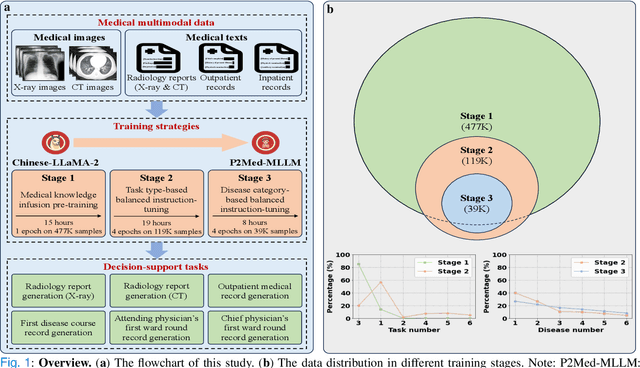
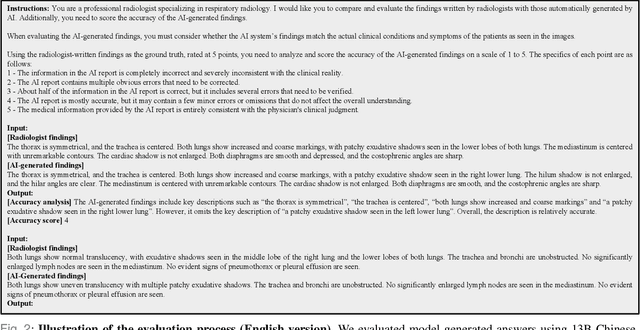
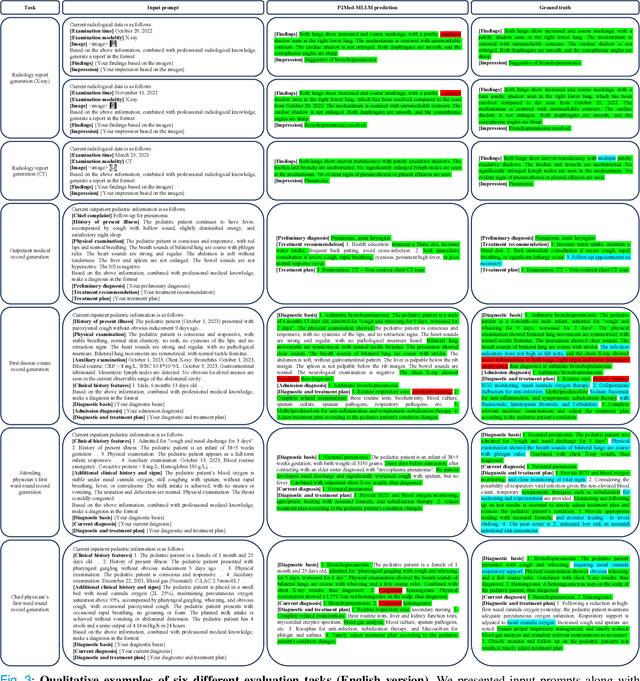
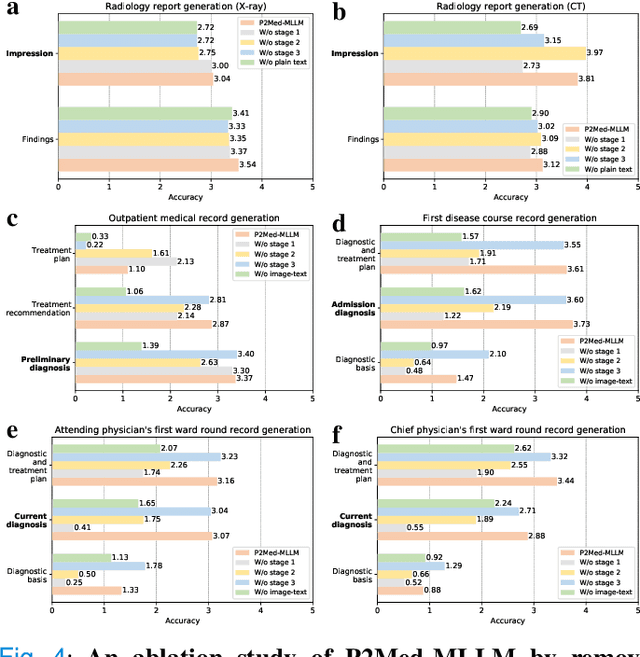
Abstract:Pediatric pneumonia is the leading cause of death among children under five years worldwide, imposing a substantial burden on affected families. Currently, there are three significant hurdles in diagnosing and treating pediatric pneumonia. Firstly, pediatric pneumonia shares similar symptoms with other respiratory diseases, making rapid and accurate differential diagnosis challenging. Secondly, primary hospitals often lack sufficient medical resources and experienced doctors. Lastly, providing personalized diagnostic reports and treatment recommendations is labor-intensive and time-consuming. To tackle these challenges, we proposed a Medical Multimodal Large Language Model for Pediatric Pneumonia (P2Med-MLLM). It was capable of handling diverse clinical tasks, such as generating free-text radiology reports and medical records within a unified framework. Specifically, P2Med-MLLM can process both pure text and image-text data, trained on an extensive and large-scale dataset (P2Med-MD), including real clinical information from 163,999 outpatient and 8,684 inpatient cases. This dataset comprised 2D chest X-ray images, 3D chest CT images, corresponding radiology reports, and outpatient and inpatient records. We designed a three-stage training strategy to enable P2Med-MLLM to comprehend medical knowledge and follow instructions for various clinical tasks. To rigorously evaluate P2Med-MLLM's performance, we developed P2Med-MBench, a benchmark consisting of 642 meticulously verified samples by pediatric pulmonology specialists, covering six clinical decision-support tasks and a balanced variety of diseases. The automated scoring results demonstrated the superiority of P2Med-MLLM. This work plays a crucial role in assisting primary care doctors with prompt disease diagnosis and treatment planning, reducing severe symptom mortality rates, and optimizing the allocation of medical resources.
MOSMOS: Multi-organ segmentation facilitated by medical report supervision
Sep 04, 2024Abstract:Owing to a large amount of multi-modal data in modern medical systems, such as medical images and reports, Medical Vision-Language Pre-training (Med-VLP) has demonstrated incredible achievements in coarse-grained downstream tasks (i.e., medical classification, retrieval, and visual question answering). However, the problem of transferring knowledge learned from Med-VLP to fine-grained multi-organ segmentation tasks has barely been investigated. Multi-organ segmentation is challenging mainly due to the lack of large-scale fully annotated datasets and the wide variation in the shape and size of the same organ between individuals with different diseases. In this paper, we propose a novel pre-training & fine-tuning framework for Multi-Organ Segmentation by harnessing Medical repOrt Supervision (MOSMOS). Specifically, we first introduce global contrastive learning to maximally align the medical image-report pairs in the pre-training stage. To remedy the granularity discrepancy, we further leverage multi-label recognition to implicitly learn the semantic correspondence between image pixels and organ tags. More importantly, our pre-trained models can be transferred to any segmentation model by introducing the pixel-tag attention maps. Different network settings, i.e., 2D U-Net and 3D UNETR, are utilized to validate the generalization. We have extensively evaluated our approach using different diseases and modalities on BTCV, AMOS, MMWHS, and BRATS datasets. Experimental results in various settings demonstrate the effectiveness of our framework. This framework can serve as the foundation to facilitate future research on automatic annotation tasks under the supervision of medical reports.
AdaOcc: Adaptive-Resolution Occupancy Prediction
Aug 24, 2024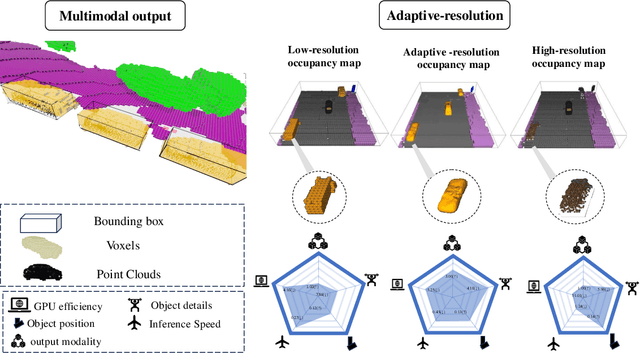

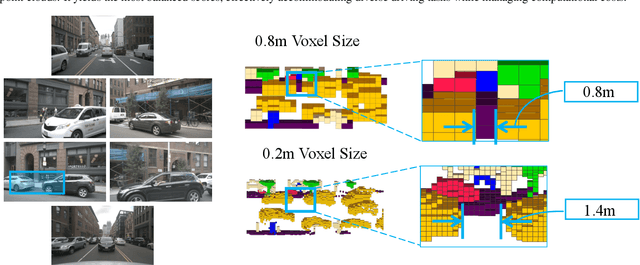
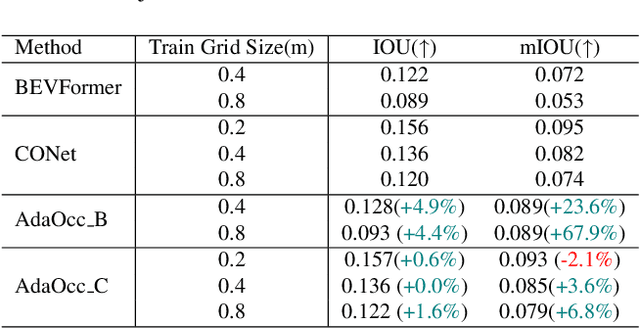
Abstract:Autonomous driving in complex urban scenarios requires 3D perception to be both comprehensive and precise. Traditional 3D perception methods focus on object detection, resulting in sparse representations that lack environmental detail. Recent approaches estimate 3D occupancy around vehicles for a more comprehensive scene representation. However, dense 3D occupancy prediction increases computational demands, challenging the balance between efficiency and resolution. High-resolution occupancy grids offer accuracy but demand substantial computational resources, while low-resolution grids are efficient but lack detail. To address this dilemma, we introduce AdaOcc, a novel adaptive-resolution, multi-modal prediction approach. Our method integrates object-centric 3D reconstruction and holistic occupancy prediction within a single framework, performing highly detailed and precise 3D reconstruction only in regions of interest (ROIs). These high-detailed 3D surfaces are represented in point clouds, thus their precision is not constrained by the predefined grid resolution of the occupancy map. We conducted comprehensive experiments on the nuScenes dataset, demonstrating significant improvements over existing methods. In close-range scenarios, we surpass previous baselines by over 13% in IOU, and over 40% in Hausdorff distance. In summary, AdaOcc offers a more versatile and effective framework for delivering accurate 3D semantic occupancy prediction across diverse driving scenarios.
 Add to Chrome
Add to Chrome Add to Firefox
Add to Firefox Add to Edge
Add to Edge